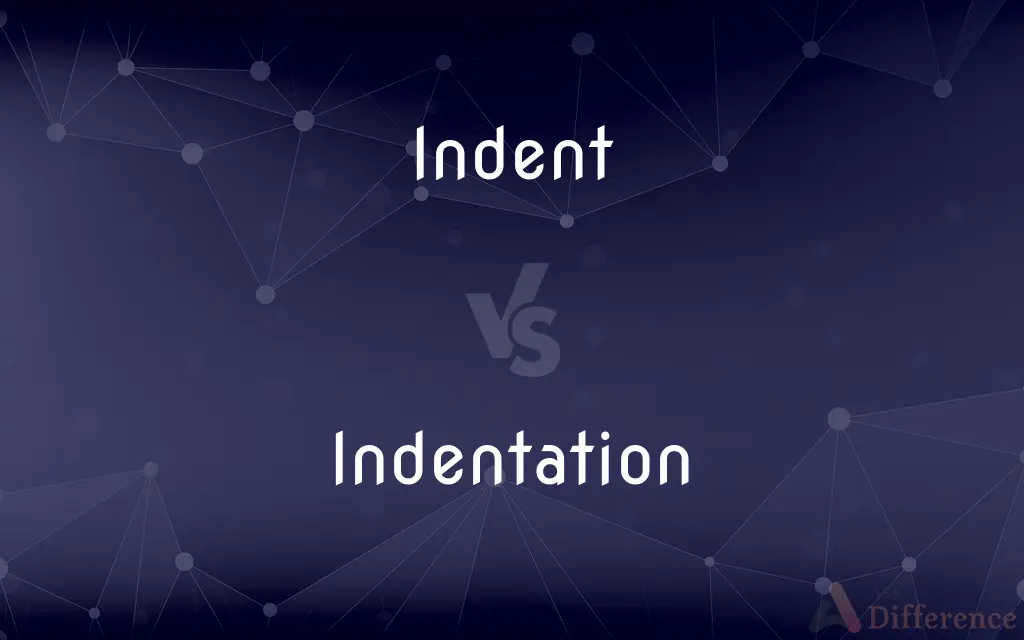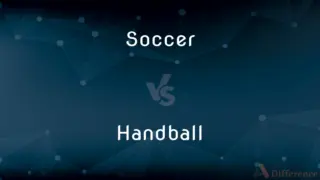Indent vs. Indentation — What's the Difference?
By Maham Liaqat & Fiza Rafique — Updated on May 2, 2024
"Indent" refers to the act of setting a line of text inward, while "indentation" is the space created by indenting text.

Difference Between Indent and Indentation
Table of Contents
ADVERTISEMENT
Key Differences
Indent is primarily a verb, describing the action of moving text away from the margin to emphasize separation, whereas indentation serves as a noun, referring to the resulting gap or space that appears after the text is indented.
Indent is used in writing to signify new paragraphs or to separate quotes from other text, while indentation commonly describes the physical space in typesetting and programming, showing where blocks of text begin relative to the rest of the content.
Indent can be implemented manually by pressing the tab key or setting a specific measurement in word processors, on the other hand, indentation might be automatically formatted in digital text editors or specified in style guides.
Indent influences readability and text organization by visually distinguishing text elements, whereas indentation plays a crucial role in programming languages by defining the structure and hierarchy of code.
Indent actions are adjustable and can vary in size depending on the document's formatting requirements, whereas indentation standards can differ significantly across various fields, such as academic writing versus computer programming.
ADVERTISEMENT
Comparison Chart
Part of Speech
Verb
Noun
Function
To create a separation by shifting text inward
The space created as a result of indenting
Use in Text
Marks new paragraphs or offset quotations
Describes the gap where text starts in a block
Implementation
Can be done by tab key or specific spacing in tools
Defined by style guides or automatic in editors
Importance
Affects readability and document organization
Crucial in coding for logical structure
Compare with Definitions
Indent
To form deep recesses.
The bay is indented by numerous coves.
Indentation
A deep recess or notch.
The coastline has several indentations formed by the sea.
Indent
To start a line of text further from the margin.
She indents the first line of every paragraph.
Indentation
The format in programming for logical structure.
Proper indentation is essential for Python scripts.
Indent
To create a contractual agreement.
The company indents with suppliers regularly.
Indentation
The action of creating indents in a material.
The tool left clear indentations in the soft metal.
Indent
To make a recess or notch.
The carpenter indented the edge of the door.
Indentation
The arrangement of text in a staggered pattern.
His code's indentation made it easy to follow.
Indent
To allocate by indenting in a document.
The clerk indents for supplies monthly.
Indentation
The space left by indenting a line or block of text.
The indentation at the start of the paragraph was too wide.
Indent
Start (a line of text) or position (a block of text) further from the margin than the main part of the text
Type a paragraph of text and indent the first line
Indentation
The act of indenting.
Indent
Form deep recesses or notches in (a line or surface)
A coastline indented by many fjords
Indentation
The condition of being indented.
Indent
Make a requisition or written order for something
We were indenting for paper clips one by one in those days
Indentation
The blank space between a margin and the beginning of an indented line.
Indent
Divide (a document drawn up in duplicate) into its two copies with a zigzag line, thus ensuring identification and preventing forgery.
Indentation
A notch or jagged cut in an edge.
Indent
Make a dent or impression in (something)
Sometimes voting-hole rectangles are merely indented by the voter's stylus
Indentation
A recess, as in a border or coastline.
Indent
An official order or requisition for goods
Hawthorn refused to approve the indent for silk scarves
Indentation
The act of indenting or state of being indented.
Indent
A space left by indenting text
Six-character indents
Indentation
A notch or recess, in the margin or border of anything.
The indentations of a leaf
Indentations of the coast
Indent
An indentation
Every indent in the coastline
Indentation
A recess or sharp depression in any surface.
Indent
An indenture.
Indentation
(typography) The act of beginning a line or series of lines at a little distance within the flush line of the column or page, as in the common way of beginning the first line of a paragraph.
Indent
To set (the first line of a paragraph, for example) in from the margin.
Indentation
A measure of the distance from the flush line.
An indentation of one em
Indent
To cut or tear (a document with two or more copies) along an irregular line so that the parts can later be matched for establishing authenticity.
Indentation
(law) A division unit of a piece of law distinguished by its indentation or by a dash.
Indent
To draw up (a document) in duplicate or triplicate.
Indentation
The act of indenting or state of being indented.
Indent
To notch or serrate the edge of; make jagged.
Indentation
A notch or recess, in the margin or border of anything; as, the indentations of a leaf, of the coast, etc.
Indent
To make notches, grooves, or holes in (wood, for example) for the purpose of mortising.
Indentation
A recess or sharp depression in any surface.
Indent
To fit or join together by or as if by mortising.
Indentation
The act of beginning a line or series of lines at a little distance within the flush line of the column or page, as in the common way of beginning the first line of a paragraph.
Indent
Chiefly British To order (goods) by purchase order or official requisition.
Indentation
A concave cut into a surface or edge (as in a coastline)
Indent
To make or form an indentation.
Indentation
The formation of small pits in a surface as a consequence of corrosion
Indent
Chiefly British To draw up or order an indent.
Indentation
The space left between the margin and the start of an indented line
Indent
To impress (a design, for example); stamp.
Indentation
The act of cutting into an edge with toothlike notches or angular incisions
Indent
The act of indenting or the condition of being indented.
Indent
A blank space before the beginning of an indented line
A two-pica indent.
Indent
An indenture.
Indent
A US certificate issued at the close of the American Revolution for interest due on the public debt.
Indent
Chiefly British An official requisition or purchase order for goods.
Indent
An indentation.
Indent
A cut or notch in the margin of anything, or a recess like a notch.
Indent
A stamp; an impression.
Indent
A certificate, or intended certificate, issued by the government of the United States at the close of the Revolution, for the principal or interest of the public debt.
Indent
A requisition or order for supplies, sent to the commissariat of an army.
Indent
(transitive) To notch; to jag; to cut into points like a row of teeth
To indent the edge of paper
Indent
(intransitive) To be cut, notched, or dented.
Indent
To dent; to stamp or to press in; to impress
Indent a smooth surface with a hammer
To indent wax with a stamp
Indent
(historical) To cut the two halves of a document in duplicate, using a jagged or wavy line so that each party could demonstrate that their copy was part of the original whole.
Indent
To enter into a binding agreement by means of such documents; to formally commit (to doing something); to contract.
Indent
To engage (someone), originally by means of indented contracts.
To indent a young man to a shoemaker; to indent a servant
Indent
(typography) To begin (a line or lines) at a greater or lesser distance from the margin. See indentation, and indention. Normal indent pushes in a line or paragraph. "Hanging indent" pulls the line out into the margin.
To indent the first line of a paragraph one em
To indent the second paragraph two ems more than the first
Indent
To crook or turn; to wind in and out; to zigzag.
Indent
To make an order upon; to draw upon, as for military stores.
Indent
To notch; to jag; to cut into points like a row of teeth; as, to indent the edge of paper.
Indent
To dent; to stamp or to press in; to impress; as, indent a smooth surface with a hammer; to indent wax with a stamp.
Indent
To bind out by indenture or contract; to indenture; to apprentice; as, to indent a young man to a shoemaker; to indent a servant.
Indent
To begin (a line or lines) at a greater or less distance from the margin; as, to indent the first line of a paragraph one em; to indent the second paragraph two ems more than the first. See Indentation, and Indention.
Indent
To make an order upon; to draw upon, as for military stores.
Indent
To be cut, notched, or dented.
Indent
To crook or turn; to wind in and out; to zigzag.
Indent
To contract; to bargain or covenant.
To indent and drive bargains with the Almighty.
Indent
A cut or notch in the margin of anything, or a recess like a notch.
Indent
A stamp; an impression.
Indent
A certificate, or intended certificate, issued by the government of the United States at the close of the Revolution, for the principal or interest of the public debt.
Indent
A requisition or order for supplies, sent to the commissariat of an army.
Indent
An order for goods to be exported or imported
Indent
The space left between the margin and the start of an indented line
Indent
Set in from the margin;
Indent the paragraphs of a letter
Indent
Cut or tear along an irregular line so that the parts can later be matched for authentication;
Indent the documents
Indent
Make a depression into;
The bicycle dented my car
Indent
Notch the edge of or make jagged
Indent
Bind by or as if by indentures, as of an apprentice or servant;
An indentured servant
Common Curiosities
Does indentation have different standards across disciplines?
Yes, the rules for indentation can vary widely between academic writing, business communication, and computer programming.
What is indentation?
Indentation refers to the space or gap that results from indenting a portion of text.
Why use an indent in writing?
Using indents helps to signal the beginning of a new paragraph and can enhance the readability of a text.
What tools can create an indent?
Indents can be created using the tab key on a keyboard, specific spacing settings in word processors, or programming IDEs.
How important is indentation in programming?
In programming, indentation is critical as it defines the structure and flow of the code, often affecting how the code is executed.
Is there a standard size for indents?
There is no universal standard; however, common practice is typically about 0.5 inches or roughly five spaces.
How does indentation affect document design?
Proper indentation contributes to a clean, organized appearance in documents, making them easier to read.
What is an indent?
An indent is an action where text is moved inward from the margin to create a visual separation.
Are indents necessary in all types of writing?
Not all writing styles require indents; for example, some business and technical writing formats use block styles.
Can indentation be used in graphic design?
Yes, graphic designers often use indentation to create visually appealing layouts and to organize text effectively.
Share Your Discovery

Previous Comparison
Soccer vs. Handball
Next Comparison
Cub vs. TaxiAuthor Spotlight
Written by
Maham LiaqatCo-written by
Fiza RafiqueFiza Rafique is a skilled content writer at AskDifference.com, where she meticulously refines and enhances written pieces. Drawing from her vast editorial expertise, Fiza ensures clarity, accuracy, and precision in every article. Passionate about language, she continually seeks to elevate the quality of content for readers worldwide.
















































